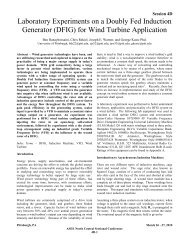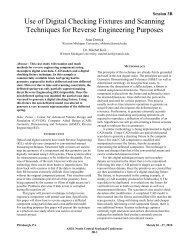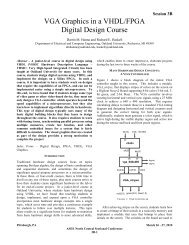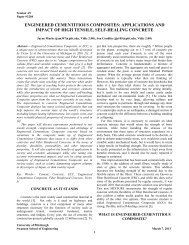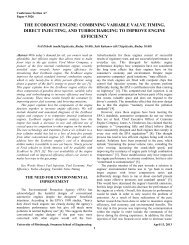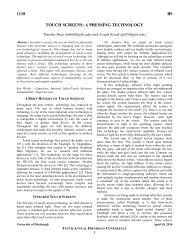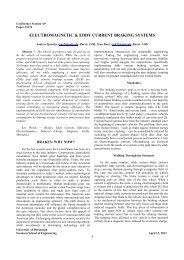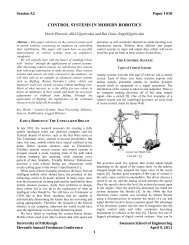design and construction of mobile surveillance robot
design and construction of mobile surveillance robot
design and construction of mobile surveillance robot
You also want an ePaper? Increase the reach of your titles
YUMPU automatically turns print PDFs into web optimized ePapers that Google loves.
Session 4CTABLE 1DECISION MATRIXCriteriaWeightHanging Carriage Hamster Ball Dual-Tread SphereScore Total Score Total Score TotalStability 25 0.0 0.0 0.5 12.5 1.0 25.0Cost 10 1.0 10.0 0.3 3.3 0.0 0.0Durability 8 0.5 4.0 0.0 0.0 1.0 8.0Power Use 6 1.0 6.0 0.0 0.0 0.5 3.0Feasibility 10 1.0 10.0 0.0 0.0 1.0 10.0Mobility 15 0.0 0.0 0.8 11.3 1.0 15.0Ease <strong>of</strong> Assembly 8 1.0 8.0 0.3 2.7 0.0 0.0Size 5 0.0 0.0 0.7 3.3 1.0 5.0Complexity 5 1.0 5.0 0.0 0.0 0.3 1.7Clarity 8 0.3 2.7 1.0 8.0 0.0 0.0Total 100 45.7 41.1 67.7The <strong>design</strong> that was selected based on the specifiedcriteria was the dual-tread <strong>design</strong>. It was determined that thedual-tread model would be the most stable <strong>and</strong> the most<strong>mobile</strong> due to its wheeled <strong>design</strong>. It should also be easier toinsert equipment inside <strong>of</strong> the dual-tread <strong>design</strong>, allowing fora smaller size which will benefit the mobility <strong>of</strong> the <strong>robot</strong>both in-use <strong>and</strong> for transportation.PROPOSED SYSTEM DESIGNThe <strong>design</strong> chosen to fulfill the requirements is a dual-tread<strong>robot</strong> with a capsule shape as shown in Figure 5.The middle cylindrical-section <strong>of</strong> the <strong>robot</strong> is stationarywhile the two wheels are domed on the outside <strong>and</strong> arecontrolled separately, allowing for a zero-turn radius. Themechanical, controls, data acquisition, <strong>and</strong> powersubsystems are contained within the middle section <strong>of</strong> the<strong>robot</strong>.The elements <strong>of</strong> the subsystems are mounted in such away that the center <strong>of</strong> gravity is well below the geometriccenter <strong>of</strong> the <strong>robot</strong>. The camera <strong>and</strong> transmitters are mountedcloser to the center <strong>of</strong> the section, on the shaft. This allowsfor a minimization <strong>of</strong> interference in the signals due to themotors <strong>and</strong> power systems. The power subsystem ismounted near the bottom <strong>of</strong> the containment section toprovide stability <strong>and</strong> to also prohibit interference from themechanical systems to the power performance.The different subsystems are hard-mounted to the shaftfor strength <strong>and</strong> stability. The central shaft remains relativelystationary as the wheels rotate around the shaft. The outershell <strong>of</strong> MSR is made <strong>of</strong> polycarbonate to increase strength<strong>and</strong> durability, while also allowing for optical clarity.Polycarbonate also has a low electrical conductivity, whichis beneficial for the power system <strong>design</strong>.FIGURE 5DUAL-TREAD ROBOT DESIGNDESIGN OF MECHANICAL SUBSYSTEMThe drive train for the Mobile Surveillance Robot consists <strong>of</strong>two (2) electric motors, four (4) gears, a stationary shaft, <strong>and</strong>two (2) wheels with bearings. The motors drive the two sets<strong>of</strong> gears, which are attached to the wheels. The wheels arePittsburgh, PA March 26 - 27, 2010ASEE North Central Sectional Conference4C-3




